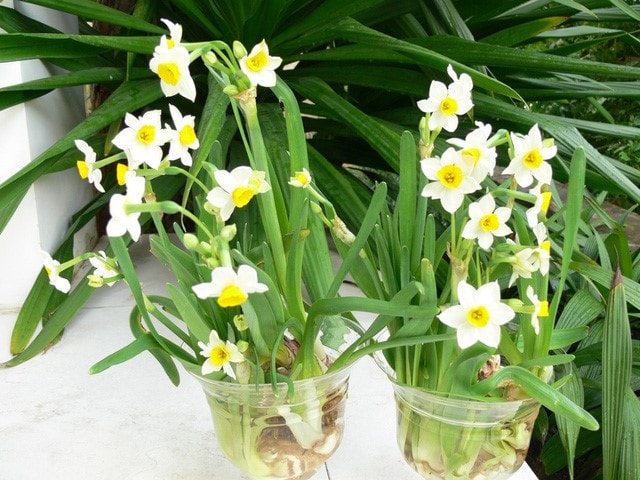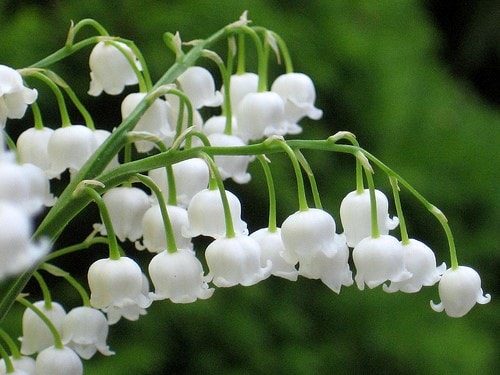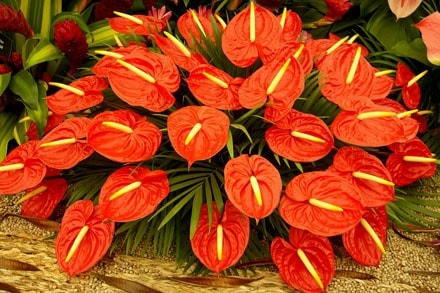Which Tet flowers are poisonous?
During Tet, families often buy flowers and ornamental plants to decorate their homes. Some flowers are very beautiful and loved by everyone but are very poisonous and can be life-threatening.
Many popular flowers displayed during Tet such as daffodils, oleanders, anthuriums... contain toxins and can be dangerous to humans.
Narcissus
Narcissus is a very familiar flower, often grown to decorate houses during Tet holidays. Narcissus has bulbs like onions, leaves like garlic leaves but thinner, arranged on both sides. The flower has six petals, in the middle of the stamens, the stamens swell and are arranged close together to form a cup-shaped "pot", jade-green in color.
The narcissus with white petals is called “silver jade bowl”. The narcissus with yellow petals is called “golden jade bowl”.
 |
| Narcissus flowers are often displayed on Tet holiday. |
However, these flowers are toxic if eaten in large quantities. Many people mistake them for onions. Some common symptoms include dizziness, vomiting, convulsions and diarrhea.
Lily of the Valley
Flowers usually grow in deep valleys, under the shade of cool streams. Each plant has only one pair of branches, each branch bearing long leaves and a cluster of blooming flowers. The flowers are small and white but very poisonous.
The poison is everywhere, from the top of the flower to the water it is in. If eaten in large amounts, the patient may experience vomiting, mouth pain, stomach pain, diarrhea, and convulsions and heart arrhythmia.
 |
| The lily of the valley is beautiful and fragrant. |
Hydrangea
This type of flower is a woody, herbaceous shrub that likes humid shade, is perennial, leaves grow opposite each node on the stem, flowers are asexual, at first the flowers are white then gradually turn blue or pink.
All parts of the plant contain toxins that can cause poisoning in humans when eaten. People may experience skin irritation, vomiting, weakness, and sweating. Some also experience coma, convulsions, and circulatory collapse.
Rhododendron
Rhododendron is a flower with diverse colors, woody plants with gray bark, leaves growing alternately, often growing in high mountainous areas. Currently, the flower is often grown in pots as an indoor ornamental plant, decoration.
The leaves and nectar of this plant are poisonous. If you accidentally eat its green leaves, your lips will burn. If you eat too much, you will get blisters, vomiting, diarrhea…
Anthurium
The plant grows in clumps, is perennial, and has a short stem. The leaves grow together on the ground, are large, oval, tapering at the tip, heart-shaped at the base, and have long, curved petioles that droop. The leaves are long, glossy green, with prominent light green palmate veins.
The inflorescence is a small spathe on a long, curved stalk. The spathe is bright red, oval-shaped with a pointed tip and a heart-shaped base with prominent green veins. The leaves and bright red flowers are poisonous. Those who eat them will experience mouth and tongue pain, swelling and blistering. If eaten in large quantities, hoarseness and difficulty swallowing will result.
 |
| Anthurium flowers have beautiful red color. |
Oleander
This is a plant with very beautiful flowers and is widely grown as an ornamental plant, fence, decoration for playgrounds, parks, sidewalks, etc. The plant is about 2-3 m tall, has beautiful flowers but has strong toxins. This substance is present in all parts of the plant, can cause eye damage when impacted or death if directly exposed.
Oleander also contains dangerous compounds such as strychnine, so chewing just one leaf is dangerous for children and chewing 10-20 leaves is dangerous for adults.
Medical advice
Flowers have beautiful colors so children are very curious, looking, touching, smelling or putting them in their mouths to taste. Therefore, it is necessary to be careful of ornamental plants that can cause poisoning to children.
Do not plant or decorate your home with potentially dangerous plants. You can choose beautiful, non-toxic flowers instead. If you have a habit, hobby, or want to plant this type of flower, you must prevent children from coming into contact with it.
For older children, caution should be taken not to eat, pick or play with the above poisonous flowers. Poisoning from flowers depends on the amount eaten, and the age, weight and sensitivity of each person. Children under 6 years of age are at higher risk.
If you suspect or detect poisoning from the above flowers, you should handle it as follows:
- If the victim accidentally eats leaves, stems, or flowers, immediately remove any remaining objects from the victim's mouth. Induce vomiting by giving the victim salt water (2 tablespoons of salt mixed with 1 cup of warm water). If the victim has not vomited, use a chicken feather to clean the throat.
Note: Do not let the child lie on his back and vomit because this can cause choking up the nose, down the lungs and can easily lead to death. During the process of inducing vomiting, always use a towel to clean the child's mouth.
- In case of skin poisoning: Wash the skin with clean water at the contaminated area for at least 15 minutes. Do not apply the cream to the contaminated areas.
Note:In all cases of poisoning, you must be taken immediately to a medical facility so that the doctor can prescribe an appropriate and timely emergency treatment regimen. You should bring vomitus to determine the toxicity.
According to Zing
| RELATED NEWS |
|---|

.jpeg)






